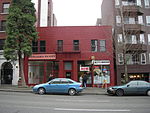The Crocodile

The Crocodile (formerly The Crocodile Cafe, and sometimes called The Croc) is a music club at 2505 1st Avenue at Wall Street in the Belltown neighborhood of Seattle, Washington, United States. Opened by Stephanie Dorgan as the "Crocodile Cafe" on April 30, 1991, it quickly became a fixture of the city's music scene. The Crocodile Cafe closed in December 2007, before being reopened as The Crocodile on March 19, 2009. Since then, the club has been owned by Alice in Chains' drummer Sean Kinney, manager Susan Silver, Portugal. The Man guitarist Eric Howk, Peggy Curtis, and Capitol Hill Block Party co-founder Marcus Charles. The Crocodile relocated to a bigger building at 2505 1st Avenue, four blocks away from its original location (2200 2nd Avenue). In 2013, Rolling Stone ranked The Crocodile as the seventh best club in the U.S., and The Guardian included the club in its list of the top 10 live music venues in Seattle. Artists such as Nirvana, Pearl Jam, Alice in Chains, Soundgarden, Mad Season, R.E.M., Ann Wilson, Mudhoney, Cheap Trick, Yoko Ono, Social Distortion, Green Day, The Strokes, Beastie Boys, Alice Merton, Billie Eilish and Tom Morello have performed at the club.
Excerpt from the Wikipedia article The Crocodile (License: CC BY-SA 3.0, Authors, Images).The Crocodile
2nd Avenue, Seattle Belltown
Geographical coordinates (GPS) Address Nearby Places Show on map
Geographical coordinates (GPS)
| Latitude | Longitude |
|---|---|
| N 47.613488 ° | E -122.344373 ° |
Address
2nd Avenue 2200
98121 Seattle, Belltown
Washington, United States
Open on Google Maps







